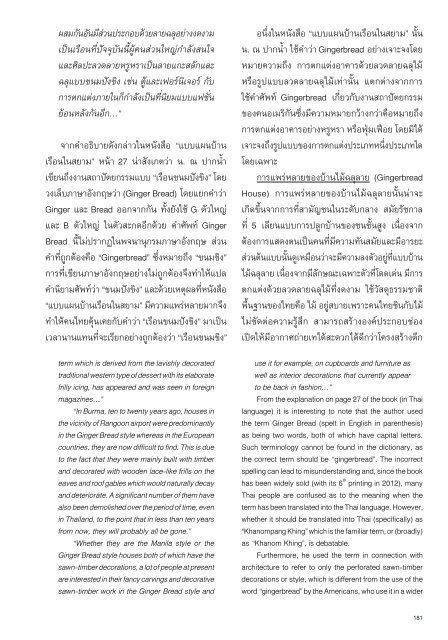บ้านเรือนถิ่นไทยในช่วงเจ็ดทศวรรษ 2489-2559
You also want an ePaper? Increase the reach of your titles
YUMPU automatically turns print PDFs into web optimized ePapers that Google loves.
ผสมกันอันมีส่วนประกอบด้วยลายฉลุอย่างงดงาม<br />
เป็นเรือนที่ปัจจุบันนี้ผู้คนส่วนใหญ่กำลังสนใจ<br />
และศิลปะลวดลายหรูหราเป็นลายแกะสลักและ<br />
ฉลุแบบขนมปังขิง เช่น ตู้และเฟอร์นิเจอร์ กับ<br />
การตกแต่งภายในก็กำลังเป็นที่นิยมแบบแฟชั่น<br />
ย้อนหลังกันอีก...”<br />
จากคำอธิบายดังกล่าวในหนังสือ “แบบแผนบ้าน<br />
เรือนในสยาม” หน้า 27 น่าสังเกตว่า น. ณ ปากน้ำ<br />
เขียนถึงงานสถาปัตยกรรมแบบ “เรือนขนมปังขิง” โดย<br />
วงเล็บภาษาอังกฤษว่า (Ginger Bread) โดยแยกคำว่า<br />
Ginger และ Bread ออกจากกัน ทั้งยังใช้ G ตัวใหญ่<br />
และ B ตัวใหญ่ ในตัวสะกดอีกด้วย คำศัพท์ Ginger<br />
Bread นี้ไม่ปรากฏในพจนานุกรมภาษาอังกฤษ ส่วน<br />
คำที่ถูกต้องคือ “Gingerbread” ซึ่งหมายถึง “ขนมขิง”<br />
การที่เขียนภาษาอังกฤษอย่างไม่ถูกต้องจึงทำให้แปล<br />
คำนิยามศัพท์ว่า “ขนมปังขิง” และด้วยเหตุผลที่หนังสือ<br />
“แบบแผนบ้านเรือนในสยาม” มีความแพร่หลายมากจึง<br />
ทำให้คนไทยคุ้นเคยกับคำว่า “เรือนขนมปังขิง” มาเป็น<br />
เวลานานแทนที่จะเรียกอย่างถูกต้องว่า “เรือนขนมขิง”<br />
term which is derived from the lavishly decorated<br />
traditional western type of dessert with its elaborate<br />
frilly icing, has appeared and was seen in foreign<br />
magazines...”<br />
“In Burma, ten to twenty years ago, houses in<br />
the vicinity of Rangoon airport were predominantly<br />
in the Ginger Bread style whereas in the European<br />
countries, they are now difficult to find. This is due<br />
to the fact that they were mainly built with timber<br />
and decorated with wooden lace-like frills on the<br />
eaves and roof gables which would naturally decay<br />
and deteriorate. A significant number of them have<br />
also been demolished over the period of time, even<br />
in Thailand, to the point that in less than ten years<br />
from now, they will probably all be gone.”<br />
“Whether they are the Manila style or the<br />
Ginger Bread style houses both of which have the<br />
sawn-timber decorations, a lot of people at present<br />
are interested in their fancy carvings and decorative<br />
sawn-timber work in the Ginger Bread style and<br />
อนึ่งในหนังสือ “แบบแผนบ้านเรือนในสยาม” นั้น<br />
น. ณ ปากน้ำ ใช้คำว่า Gingerbread อย่างเจาะจงโดย<br />
หมายความถึง การตกแต่งอาคารด้วยลวดลายฉลุไม้<br />
หรือรูปแบบลวดลายฉลุไม้เท่านั้น แตกต่างจากการ<br />
ใช้คำศัพท์ Gingerbread เกี่ยวกับงานสถาปัตยกรรม<br />
ของคนอเมริกันซึ่งมีความหมายกว้างกว่าคือหมายถึง<br />
การตกแต่งอาคารอย่างหรูหรา หรือฟุ่มเฟือย โดยมิได้<br />
เจาะจงถึงรูปแบบของการตกแต่งประเภทหนึ่งประเภทใด<br />
โดยเฉพาะ<br />
การแพร่หลายของบ้านไม้ฉลุลาย (Gingerbread<br />
House) การแพร่หลายของบ้านไม้ฉลุลายนั้นน่าจะ<br />
เกิดขึ้นจากการที่สามัญชนในระดับกลาง สมัยรัชกาล<br />
ที่ 5 เลียนแบบการปลูกบ้านของชนชั้นสูง เนื่องจาก<br />
ต้องการแสดงตนเป็นคนที่มีความทันสมัยและมีอารยะ<br />
ส่วนต้นแบบนั้นดูเหมือนว่าจะมีความลงตัวอยู่ที่แบบบ้าน<br />
ไม้ฉลุลาย เนื่องจากมีลักษณะเฉพาะตัวที่โดดเด่น มีการ<br />
ตกแต่งด้วยลวดลายฉลุไม้ที่งดงาม ใช้วัสดุธรรมชาติ<br />
พื้นฐานของไทยคือ ไม้ อยู่สบายเพราะคนไทยชินกับไม้<br />
ไม่ขัดต่อความรู้สึก สามารถสร้างองค์ประกอบช่อง<br />
เปิดให้มีอากาศถ่ายเทได้สะดวกได้ดีกว่าโครงสร้างตึก<br />
use it for example, on cupboards and furniture as<br />
well as interior decorations that currently appear<br />
to be back in fashion...”<br />
From the explanation on page 27 of the book (in Thai<br />
language) it is interesting to note that the author used<br />
the term Ginger Bread (spelt in English in parenthesis)<br />
as being two words, both of which have capital letters.<br />
Such terminology cannot be found in the dictionary, as<br />
the correct term should be “gingerbread”. The incorrect<br />
spelling can lead to misunderstanding and, since the book<br />
has been widely sold (with its 6 th printing in 2012), many<br />
Thai people are confused as to the meaning when the<br />
term has been translated into the Thai language. However,<br />
whether it should be translated into Thai (specifically) as<br />
“Khanompang Khing” which is the familiar term, or (broadly)<br />
as “Khanom Khing”, is debatable.<br />
Furthermore, he used the term in connection with<br />
architecture to refer to only the perforated sawn-timber<br />
decorations or style, which is different from the use of the<br />
word “gingerbread” by the Americans, who use it in a wider<br />
181


















